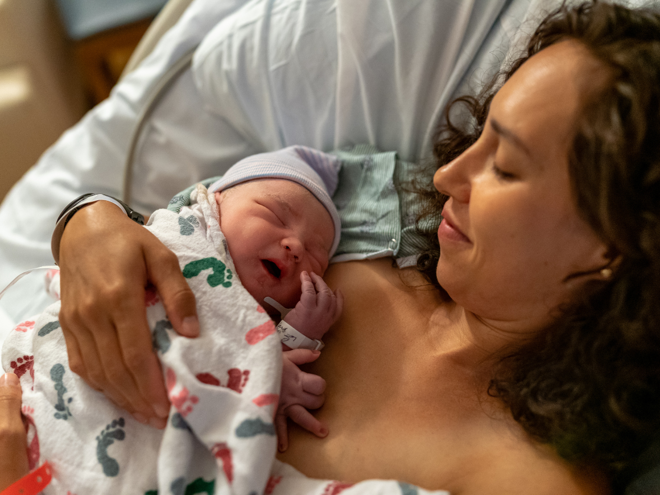
A caesarean section (otherwise referred to as a c section, caesarean or caesar) is a medical procedure where a baby is born through an incision (cut) made in the mother’s abdomen and womb. There may be several reasons for giving birth by c section including breech birth, problems with the placenta, or multiple births (i.e., twins, triplets). Some women may also choose to have a caesarean for other reasons. Discuss your options with your healthcare professional who can talk to you more about your personal situation and preferences. They can also talk to you about c section risks and possible complications.
Here are a few things to consider about a c section:
- Ask about your options for c section pain medication and anesthesia.
- If you are at high risk of blood clots you may be required to wear compression stockings either during and/or after surgery.
- No matter which anesthetic is used, skin-to-skin contact with your baby will be important as soon as possible to enhance bonding and establishment of breastfeeding. Speak with the midwife or a lactation consultant about the most comfortable breastfeeding position considering your wound area.
- Some babies may be taken to the special care nursery (SCN) after the delivery for a period of time if they are unwell.
- Be prepared to stay in hospital for up to 3-5 days afterwards. This can vary depending on the hospital and your recovery from a c section delivery.
- If you’re expecting multiple babies (twins, triplets) your likelihood of needing a c section increases.
- Recovering from a c section delivery is usually longer than the recovery period for a vaginal birth, usually around six weeks. During this time you shouldn’t lift anything heavier than your baby. You also won’t be able to drive during this period and should speak to your healthcare professional about when it is safe to drive again.
- As a c section is a surgical procedure, there will likely be some pain post operation. This can usually be managed with standard pain relief.
- There is a higher chance that for subsequent births you may also need a caesarean section. This is a discussion that can be had with your healthcare professional and will depend on individual circumstances.
- Talk to other mums who have had a c section. Experiences can often be different to what you expect.
- No matter how you decide to deliver your baby, pre-birth exercises to strengthen pelvic and stomach muscles are recommended to reduce incontinence post pregnancy. Talk to a physiotherapist or your doctor about safe pelvic floor exercises.
Things to consider when recovering from a c section:
As with any surgery, recovering from a c section takes time and self-care. If your c section is uncomplicated you will likely stay in hospital for around 3 to 5 days, and then will have limited activities for around 6 weeks where you won’t be able to lift anything heavy or drive. Your healthcare professional will be able to give you specific care instructions and guide you on what you can and can’t do during your caesarean section recovery period.
- Engage your support system now. Ask family and friends to help for at least the first couple of weeks as part of your post c section care. Tasks such as cleaning, cooking, and playing with your older children (if you have any) might be harder for you in your recovery period. Try not to strain yourself so that you can heal as quickly as possible.
- Follow your healthcare professional's advice and avoid carrying anything heavier than your baby. If you have older children who want your attention, try activities that don’t involve you picking them up such as reading a book on the couch or bed together.
- If you know you’re having a c section, consider batch cooking and freezing some meals before you go into hospital. Soups or healthy meals full of vegetables are a good option. Here are some great freezer meal recipe ideas. Stock up your fridge and food cupboards before you return from hospital. Ask family or friends to help or place an online grocery order for when you get home. You’ll need someone there to help unpack it though.
- You’ll need to gently clean your c section incision daily to help prevent infection. Your midwife or healthcare professional will advise you on the specifics such as how to clean your incision, and whether to cover the scar or leave it to air. If your wound is unusually sore, speak to your healthcare professional, and don’t delay. They will check the wound for infection and might recommend pain relief for you.
- Wear loose, comfortable clothing that won’t irritate your wound, and underwear that goes higher than your incision (rather than sits on it). Full brief underwear and soft, cotton high waisted pants are generally better because they don’t sit right on the wound.
- Put yours and baby’s everyday essentials (food, clothes, toiletries and cutlery) within easy reach so you won’t need to stretch up or bend low, to reduce strain on your incision.
- Maintain a healthy diet while breastfeeding. Eat plenty of high fiber fruit, vegetables and grains, and drink lots of water to help avoid constipation and stay hydrated.
- You won’t be able to drive for up to six weeks so if you need to get around, you’ll need to take public transport, a taxi or ask friends and family for lifts. Check with your car insurance provider about when you are insured to drive again.
- Consider a breastfeeding pillow to make feeding your baby more comfortable and to protect your incision. The midwives will be able to show you comfortable positions after your baby is born so that you can be more confident when you return home. If you need some more ideas of breastfeeding positions, check out our article.
- Try not to do anything strenuous until your c section six-week postnatal check-up. Try to stay active by going for short and gentle walks during the day, even just around the house.
Frequently asked questions about c section
What is a c section?
A c section, or caesarean section, is a surgical procedure used to deliver a baby through incisions made in the mother's abdomen and uterus. It may be planned or done in emergencies when a vaginal delivery poses risks to the mother or baby. Post c section care and recovery typically takes longer than with vaginal births.
How long does a caesarean section take?
A caesarean section usually takes between 30 minutes to an hour to complete. This includes the time for anesthesia, the actual delivery of the baby, and closing the incision. However, total time in the operating room may be longer due to preparation and recovery processes.
How many caesareans can you have?
There is no strict limit to the number of caesarean sections a woman can have; however, each subsequent surgery may carry increased risks, such as complications. Many women have multiple c sections safely, but it's essential to consult with a healthcare professional for personalised advice.
How many layers are cut during c section?
During a caesarean section, several layers are typically cut through to reach the baby. These include skin (the outermost layer); subcutaneous tissue (the fat layer beneath the skin); fascia (a tough layer of connective tissue); peritoneum (the lining of the abdominal cavity); and uterine wall (the final layer where the incision is made to access the baby). Surgeons carefully close each layer after the delivery to promote healing, post c section care and recovery.
How does a c section work?
A caesarean section (c section) involves an anesthetic, followed by incisions in the abdominal wall and uterus. The baby is then delivered through these incisions, and the placenta is removed. Finally, the surgeon closes the uterus and abdominal layers, after which the mother is monitored while recovering from the c section.
Sources
- Raising Children Website. Accessed at Elective caesarean birth: what to expect | Raising Children Network
- The Royal Australian and New Zealand College of Obstetricians and gynecologists'. Accessed at Caesarean section



